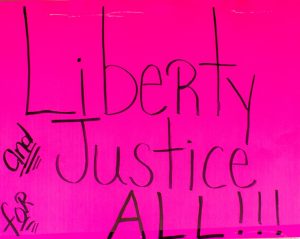DEAI work in the 10th anniversary of the Black Lives Matter movement
By Amy Golden-Shepherd, Delaware Division of Historical and Cultural Affairs deputy director, Vertie Lee, curator of education, and Elizabeth Coulter, curator of collections

After the acquittal of Trayvon Martin’s (1995-2012) murderer in 2013, the global organization, Black Lives Matter, was founded to end violence inflicted on Black communities and to create space for Black innovation. Now, a decade has passed and the movement has greatly impacted American politics and society.
The museum field has reacted to recent social change from the Black Lives Matter movement in disparate ways. Many museum professionals have worked to confront and dismantle systemic injustices through daily practices not only in public-facing initiatives, but also in the structure of work environments.
In recent years, the Division of Historical and Cultural Affairs has made progress in its diversity, equity, accessibility and inclusion (DEAI) practices. This focus is embedded in the work of the division’s strategic plan for the next five years, and efforts are supported by committees and staff members championing DEAI work on a regular basis. There are several initiatives to address past inequities, as well as restorative actions that support contemporary communities in Delaware.
In 2020, the division established its Race and Equity Committee to give employees a space to engage in difficult conversations, process the daily harms and successes of society, learn from the specific historical expertise of colleagues and build cultural competence. Cultural competency is the skill set that allows people to interact respectfully with people who have identities different from their own. It is critical that we each develop an understanding of the intersection of our own identities and how our unique makeup influences our movement through the world. In workshop and small group settings, division employees have been sharing their cultural stories, recognizing implicit biases, learning how to stop perpetrating microaggressions and conversely building community using microaffirmations. Employees are learning about systemic issues of injustice and how they impact our daily lives. As members of the division do the personal work needed to become more empathetic and inclusive individuals, the division as a whole is working to engage with community partners in more authentic ways. Equipped with an open mindset and a proclivity toward sharing inclusive history, members of each team are engaged in exciting initiatives.
DEAI work extends to the day-to-day work in the state’s history collection. In 2020, the collections team drafted a Collection Development Plan that outlined the current state of the collection. This plan included strategies that better supported the division’s DEAI goals. From the plan, staff has increased accessibility to the collection in person at historic sites, research appointments, programs, as well as digitally through newsletter articles and Instagram posts @DelawareHistory. Also, among these changes, they have directed particular focus on collection research, conservation and new acquisitions centered on Black history in Delaware. Specifically, the division participated in a growing trend in the museum field to conduct “rapid response collecting,” the practice of collecting material culture as history is happening. The division collected Black Lives Matter protest shirts and a face mask, artworks by James Wyatt and Jannah Williams and a protest sign to make sure this movement was represented in the state’s history. The division hopes to continue to collect material culture as history is happening, as well as older objects, so these moments and the personal stories are preserved and represented in the history of the state.
The division also supports educators and students to develop their knowledge about all of Delaware’s history, both the triumphant and the troubling. In January 2021, the division developed a Diversity in Delaware History webinar series for educators to develop a historical context for both present times and Delaware’s history. Currently in its third year, the webinar series discusses troubling truths, inequitable laws and the resilience of communities living within Delaware. With the implementation of House Bill 198, which requires each school district and charter school to establish and implement a curriculum on Black history for students from kindergarten through high school, the division is compiling resources and narratives to complement the curriculum.
Two of the division’s museums also currently have online resources to support broadening narratives and perspectives. The Segregated Sands exhibit brings to the forefront the history and stories of the Black American experience at Delaware’s segregated beaches during the Jim Crow era. At the John Dickinson Plantation, John Dickinson, known as the “Penman of the Revolution,” was one of America’s founding fathers who wrote of freedom and liberty for all while holding human beings in bondage. The staff tell the stories of the tenant farmers, indentured servants, free and enslaved Black men, women and children who lived, worked and died on the plantation. The division is making a listing of enslaved and free Black people available and accessible to the general public and researchers. Research is ongoing as is work on a standalone website.
Though there is much more work to be done, the division and its staff are committed to making changes in the workplace and historic sites to best support diversity, equity, accessibility and inclusion every day. It is the hope that in another decade of dedication and perseverance, the division and the museum field will be closer to accomplishing this goal.


